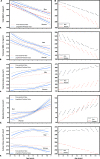Longitudinal changes in BMD and bone geometry in a population-based study
- PMID: 17997708
- PMCID: PMC2645701
- DOI: 10.1359/jbmr.071103
Longitudinal changes in BMD and bone geometry in a population-based study
Abstract
We prospectively examined vBMD and structural bone parameters assessed by QCT among participants of the InCHIANTI study over a 6-yr follow-up. Periosteal apposition occurred both in men and women. Endocortical resorption causes bone loss in older women despite periosteal apposition.
Introduction: To address the hypothesis that age-related changes in BMD and bone geometry may be different in men and women, we prospectively examined volumetric BMD (vBMD) and structural bone parameters assessed by QCT among participants of the InCHIANTI study over a 6-yr follow-up.
Materials and methods: Three hundred forty-five men and 464 women 21-102 yr of age from the InCHIANTI study, a population-based study in Tuscany, Italy, were included. Tibial QCT bone parameters were measured at enrollment (1998-2000) and at 3- (2001-2003) and 6-yr (2004-2006) follow-ups.
Results: Periosteal apposition occurred both in men and women. The annual rate of bone periosteal apposition was higher in younger than in older men, whereas in women, the rate of apposition was homogenous across age groups. The age-related medullary expansion, expression of endocortical resorption, was significantly higher in women compared with men. In women, but not in men, accelerated endocortical resorption not sufficiently balanced by periosteal apposition caused accelerated loss in cortical bone mass. The cross-sectional moment of inertia decreased progressively over the life span in both sexes.
Conclusions: Endocortical resorption causes bone loss in older women despite periosteal apposition. Obtaining a balance between endocortical resorption and periosteal apposition should be the target for interventions aimed to decrease bone loss and prevent osteoporosis in older women.
Figures



Similar articles
-
Bone fragility: failure of periosteal apposition to compensate for increased endocortical resorption in postmenopausal women.J Bone Miner Res. 2006 Dec;21(12):1856-63. doi: 10.1359/jbmr.060904. J Bone Miner Res. 2006. PMID: 17002580 Clinical Trial.
-
Population-based study of age and sex differences in bone volumetric density, size, geometry, and structure at different skeletal sites.J Bone Miner Res. 2004 Dec;19(12):1945-54. doi: 10.1359/JBMR.040916. Epub 2004 Sep 20. J Bone Miner Res. 2004. PMID: 15537436
-
Association of bone turnover markers with volumetric bone loss, periosteal apposition, and fracture risk in older men and women: the AGES-Reykjavik longitudinal study.Osteoporos Int. 2016 Dec;27(12):3485-3494. doi: 10.1007/s00198-016-3675-7. Epub 2016 Jun 24. Osteoporos Int. 2016. PMID: 27341810 Free PMC article.
-
The structural basis of bone fragility in men.Bone. 1999 Jul;25(1):143-7. doi: 10.1016/s8756-3282(99)00117-9. Bone. 1999. PMID: 10423041 Review.
-
Unresolved issues in osteoporosis in men.Rev Endocr Metab Disord. 2001 Jan;2(1):45-64. doi: 10.1023/a:1010054924085. Rev Endocr Metab Disord. 2001. PMID: 11704979 Review.
Cited by
-
Temporal and Quantitative Transcriptomic Differences Define Sexual Dimorphism in Murine Postnatal Bone Aging.JBMR Plus. 2021 Dec 10;6(2):e10579. doi: 10.1002/jbm4.10579. eCollection 2022 Feb. JBMR Plus. 2021. PMID: 35229061 Free PMC article.
-
Estrogens and Androgens in Skeletal Physiology and Pathophysiology.Physiol Rev. 2017 Jan;97(1):135-187. doi: 10.1152/physrev.00033.2015. Physiol Rev. 2017. PMID: 27807202 Free PMC article. Review.
-
Androgens and estrogens in skeletal sexual dimorphism.Asian J Androl. 2014 Mar-Apr;16(2):213-22. doi: 10.4103/1008-682X.122356. Asian J Androl. 2014. PMID: 24385015 Free PMC article. Review.
-
Rates of bone loss in young adult males.Int J Clin Rheumtol. 2010 Apr 1;5(2):215-228. doi: 10.2217/ijr.10.7. Int J Clin Rheumtol. 2010. PMID: 20625439 Free PMC article.
-
Effects of Hormone Replacement Therapy on Bone Mineral Density in Korean Adults With Turner Syndrome.J Korean Med Sci. 2024 Jan 8;39(1):e9. doi: 10.3346/jkms.2024.39.e9. J Korean Med Sci. 2024. PMID: 38193328 Free PMC article.
References
-
- Seeman E. The periosteum-a surface for all seasons. Osteoporos Int. 2007;18:123–128. - PubMed
-
- Seeman E, Delmas PD. Bone quality—the material and structural basis of bone strength and fragility. N Engl J Med. 2006;354:2250–2261. - PubMed
-
- NIH Consensus Statement Online. Osteoporosis prevention, diagnosis, and therapy. 2000. Available online at http://consensus.nih.gov/2000/2000Osteoporosis111html.htm. - PubMed
-
- Riggs BL, Melton LJ, III, Robb RA, Camp JJ, Atkinson EJ, Peterson JM, Rouleau PA, McCollough CH, Bouxsein ML, Khosla S. Population-based study of age and sex differences in bone volumetric density, size, geometry, and structure at different skeletal sites. J Bone Miner Res. 2004;19:1945–1954. - PubMed
-
- Ahlborg HG, Johnell O, Turner CH, Rannevik G, Karlsson MK. Bone loss and bone size after menopause. N Engl J Med. 2003;349:327–334. - PubMed
Publication types
MeSH terms
Grants and funding
LinkOut - more resources
Full Text Sources
Medical

